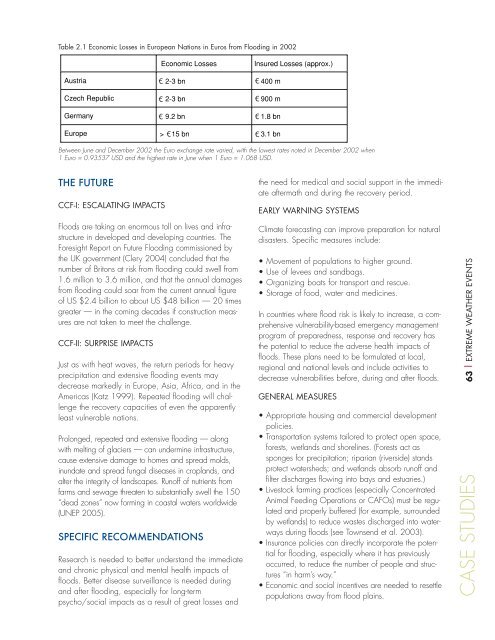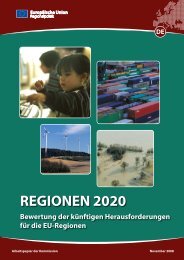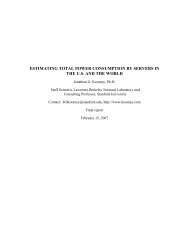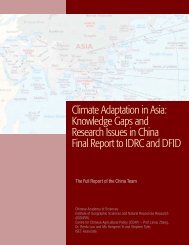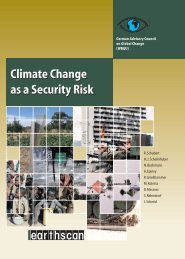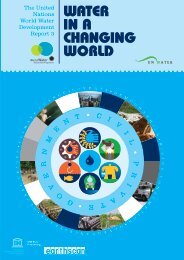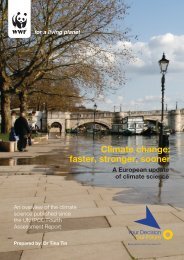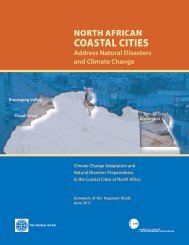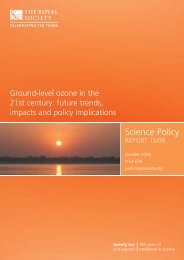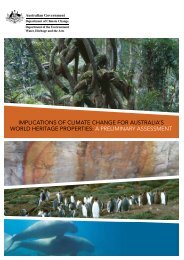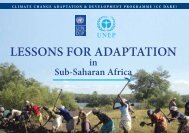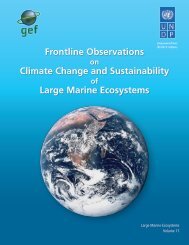Climate change futures: health, ecological and economic dimensions
Climate change futures: health, ecological and economic dimensions
Climate change futures: health, ecological and economic dimensions
Create successful ePaper yourself
Turn your PDF publications into a flip-book with our unique Google optimized e-Paper software.
Table 2.1 Economic Losses in European Nations in Euros from Flooding in 2002Economic LossesInsured Losses (approx.)Austria 2-3 bn 400 mCzech Republic 2-3 bn 900 mGermany 9.2 bn 1.8 bnEurope > 15 bn 3.1 bnBetween June <strong>and</strong> December 2002 the Euro ex<strong>change</strong> rate varied, with the lowest rates noted in December 2002 when1 Euro = 0.93537 USD <strong>and</strong> the highest rate in June when 1 Euro = 1.068 USD.THE FUTURECCF-I: ESCALATING IMPACTSFloods are taking an enormous toll on lives <strong>and</strong> infrastructurein developed <strong>and</strong> developing countries. TheForesight Report on Future Flooding commissioned bythe UK government (Clery 2004) concluded that thenumber of Britons at risk from flooding could swell from1.6 million to 3.6 million, <strong>and</strong> that the annual damagesfrom flooding could soar from the current annual figureof US $2.4 billion to about US $48 billion — 20 timesgreater — in the coming decades if construction measuresare not taken to meet the challenge.CCF-II: SURPRISE IMPACTSJust as with heat waves, the return periods for heavyprecipitation <strong>and</strong> extensive flooding events maydecrease markedly in Europe, Asia, Africa, <strong>and</strong> in theAmericas (Katz 1999). Repeated flooding will challengethe recovery capacities of even the apparentlyleast vulnerable nations.Prolonged, repeated <strong>and</strong> extensive flooding — alongwith melting of glaciers — can undermine infrastructure,cause extensive damage to homes <strong>and</strong> spread molds,inundate <strong>and</strong> spread fungal diseases in cropl<strong>and</strong>s, <strong>and</strong>alter the integrity of l<strong>and</strong>scapes. Runoff of nutrients fromfarms <strong>and</strong> sewage threaten to substantially swell the 150“dead zones” now forming in coastal waters worldwide(UNEP 2005).SPECIFIC RECOMMENDATIONSResearch is needed to better underst<strong>and</strong> the immediate<strong>and</strong> chronic physical <strong>and</strong> mental <strong>health</strong> impacts offloods. Better disease surveillance is needed during<strong>and</strong> after flooding, especially for long-termpsycho/social impacts as a result of great losses <strong>and</strong>the need for medical <strong>and</strong> social support in the immediateaftermath <strong>and</strong> during the recovery period.EARLY WARNING SYSTEMS<strong>Climate</strong> forecasting can improve preparation for naturaldisasters. Specific measures include:• Movement of populations to higher ground.• Use of levees <strong>and</strong> s<strong>and</strong>bags.• Organizing boats for transport <strong>and</strong> rescue.• Storage of food, water <strong>and</strong> medicines.In countries where flood risk is likely to increase, a comprehensivevulnerability-based emergency managementprogram of preparedness, response <strong>and</strong> recovery hasthe potential to reduce the adverse <strong>health</strong> impacts offloods. These plans need to be formulated at local,regional <strong>and</strong> national levels <strong>and</strong> include activities todecrease vulnerabilities before, during <strong>and</strong> after floods.GENERAL MEASURES• Appropriate housing <strong>and</strong> commercial developmentpolicies.• Transportation systems tailored to protect open space,forests, wetl<strong>and</strong>s <strong>and</strong> shorelines. (Forests act assponges for precipitation; riparian (riverside) st<strong>and</strong>sprotect watersheds; <strong>and</strong> wetl<strong>and</strong>s absorb runoff <strong>and</strong>filter discharges flowing into bays <strong>and</strong> estuaries.)• Livestock farming practices (especially ConcentratedAnimal Feeding Operations or CAFOs) must be regulated<strong>and</strong> properly buffered (for example, surroundedby wetl<strong>and</strong>s) to reduce wastes discharged into waterwaysduring floods (see Townsend et al. 2003).• Insurance policies can directly incorporate the potentialfor flooding, especially where it has previouslyoccurred, to reduce the number of people <strong>and</strong> structures“in harm’s way.”• Economic <strong>and</strong> social incentives are needed to resettlepopulations away from flood plains.63 | EXTREME WEATHER EVENTSCASE STUDIES


